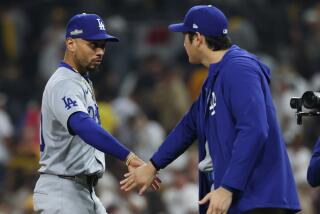Bad Old Braves : Atlanta’s Success Is a Relatively Recent Phenomenon
WEST PALM BEACH — The Atlanta Braves have been so good the past five years, they’ve almost been able to rewrite history. This team didn’t always play in October against a team from the other league. It didn’t draw 3 million fans every year.
Not so long ago, you could make a strong case that this was the worst franchise in the National League.
Take the 1988 Braves. Please.
That stinker of a team was the worst in Atlanta history, losing 106 games with a lineup that included such hole-in-the-bat hitters as Terry Blocker (.212 average) and a hanging-curve pitching staff led by top winner Rick Mahler (9-16).
But that team certainly wasn’t alone in its ineptitude. Atlanta was fifth or sixth in the six-team NL West every year from 1985 through 1990--and don’t forget a stretch of four straight last-place finishes from 1976-79.
“It was a team that was not good,” said manager Bobby Cox, who has been with the Braves since 1978 except for a four-year managerial stint with Toronto. “It needed to be rebuilt completely over, and basically that’s what we did.”
How bad were the old Braves? They lost 300 games between 1988 and ’90. They dropped 17 straight in 1977, prompting owner Ted Turner to take a one-game stint as manager. He lost, too.
The old Braves ranged from the remarkable to the ridiculous.
The 1973 team was the only one in major league history to have three players with 40 homers, yet they still finished fifth in the West because the pitching staff had a 4.25 ERA.
For a short time in the 1970s, the players wore nicknames on the back of their uniforms. Pitcher Andy Messersmith, No. 17, was dubbed “Channel” in a blatant, though short-lived advertisement for Turner’s television station.
The old Braves were scorned by a city whose motto is “Too Busy to Hate.”
For a late-season game against Houston in 1975, a grand total of 737 people made their way through the turnstiles at Atlanta-Fulton County Stadium. At one concession stand, a solitary worked manned the counter and still had plenty of time to cut coupons from the Sunday newspaper.
“You like to be at a stadium that’s packed,” Cox said. “But if you don’t put a good product on the field, hell, no one is going to come.”
Tom Glavine was a rookie starting pitcher in 1988, someone who probably should have still been in Triple-A. But the Braves didn’t have anyone better, so he was forced to take a pounding in the big leagues. He went 7-17 with a 4.56 ERA.
Among the other current Braves who made their major league debuts that year: John Smoltz, who went 2-7 with a 5.48 ERA in 12 starts; second baseman Mark Lemke and shortstop Jeff Blauser, who got late-season call-ups and hit .224 and .239, respectively.
“It’s still fresh in our minds,” Glavine said. “I think that will keep us from getting complacent.”
All four of those players have seen the worst of times and the best of times. Beginning in 1991, the Braves began a remarkable streak that includes four division titles, three NL titles and Atlanta’s first World Series victory last year.
There were a couple of blips of success before 1991. The Braves won the NL West titles in 1969 and 1982, but were swept in the league championship series both years.
More indicative was the 1977 team, which finished 61-101, 37 games behind Los Angeles. Outfielder Jeff Burroughs had a brilliant year with 41 homers and 114 RBIs, but the pitching was atrocious. The 4.85 ERA is still the worst in Atlanta history.
Bad pitching was a familiar theme for the bad, old Braves, who generally assembled a team that could hit plenty of homers at Atlanta Stadium, a.k.a. “The Launching Pad,” but couldn’t stop the other teams from hitting even more.
Finally, Cox decided a change of philosophy was the only way to change the losing ways.
While he was general manager in the late-1980s, Cox set out to acquire as many good, young arms as he could. He drafted Glavine, Steve Avery and Mark Wohlers, and acquired Smoltz from the Detroit farm system.
“Our pitching,” Cox said flatly, “is what turned it around.”
So when you mention Larvell “Sugar Bear” Blanks (shortstop, circa 1975), expect a bunch of puzzled looks, as if there’s no way he is part of this team’s heritage.
For these players, Braves history begins in 1991.
More to Read
Go beyond the scoreboard
Get the latest on L.A.'s teams in the daily Sports Report newsletter.
You may occasionally receive promotional content from the Los Angeles Times.










